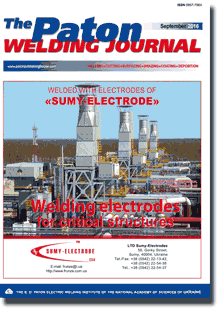| 2016 №09 (09) |
DOI of Article 10.15407/tpwj2016.09.10 |
2016 №09 (11) |

The Paton Welding Journal, 2016, #9, 47-50 pages
Selection of modes of high-temperature tempering of heat-resistant steel welded joints made by electrodes thermanit MTS616
V.Yu. Skulsky, A.K. Tsaryuk, A.R. Gavrik, M.A. Nimko and G.N. Strizhius
E.O. Paton Electric Welding Institute, NASU 11 Kazimir Malevich Str., 03680, Kiev, Ukraine. E-mail: office@paton.kiev.ua
Abstract
One of the problems in producing the welded joints of complexly-alloyed heat-resistant steels is the providing of the required level of weld metal impact toughness. The improvement of its ductility and toughness is attained by a postweld high-temperature tempering using the modes regulated by the developer of welding electrodes. In case of welding of an experimental high-chromium martensite steel by electrodes Thermanit MTS616 (10Kh9V2MFB type) with account for conditions of its fulfillment, the heat treatment was required by 30–40 oC lower than that usually applied for welds of the mentioned type. The effect of modes of the manual arc welding and duration of tempering at 730–720 oC on hardness and impact toughness of weld metals was determined. Intervals of holdings were found in tempering, during which the secondary hardening was observed. The modes were selected, providing the required level of impact toughness of welds (impact energy KV ≤ 41 J). It is shown that alongside with the selected duration of temperature the important factor, providing the increase in toughness of the deposited metal, is the application of multi-pass welding at the reduced energy input. 11 Ref., 4 Figures.
Keywords: heat-resistant martensite steel, manual arc welding with covered electrodes, weld metal, high-temperature heat treatment, tempering mode, hardness, impact toughness
Received: 29.02.16
Published: 09.10.16
References
- Bergquist, E.-L. (1999) Consumables and welding modified 9Cr-1Mo steel. Svetsaren, 1/2, 22–25.
- Hoiser, G. (1997) Filler materials for welding in power machine building. Svarka, 9, 40–44, 47.
- Petrov, G.L., Zemzin, V.N., Gonserovsky, F.G. (1963) Welding of heat-resistant stainless steels. Moscow: Mashgiz.
- Z phase strengthened steels for ultra-supercritical power plants. http://www.z-ultra.eu
- (2005) Welding filler metals. Welding guide. Hamm: Boehler Thyssen Schweisstechnik.
- Rosenbrock, L.A. (2001) A critical overview of the welding of P91 material. Australian Welding J., 46(2nd), 5–8.
- , W., Mischok, W., Wellnitz, G. et al. (1994) Welding of new types of steel for power plant construction. In: Proc. of Conf. on Welding and Cutting (Germany, Bremen, 28–30 Sept. 1994). Boehler Welding Special Add.
- DIN EN ISO 15614-1: Anforderung und Qualifizierung von Schweissverfahren fuer metallische Werkstoffe – Schweissverfahrenspruefung. Teil 1: Lichtbogen- und Gasschweissen von Staehlen und Lichtbogenschweissen von Nickel und Nickellegierungen. Deutsche Fassung prEN ISO 15614-1:2013.
- DIN CEN ISO/TR 15608: Schweissen – Richtlinien fuer eine Gruppeneinteilung von metallischen Werkstoffen. Deutsche Fassung CEN ISO/TR 15608:2013.
- Mokhila, P., Foldynova, K. (2014) Influence of postweld heat treatment on mechanical properties of R92 steel welded joints made by submerged-arc welding. Metallovedenie i Termich.Obrab. Metallov, 4, 36–39.
- BS EN 1021602:2002: Seamless steel tubes for pressure purposes. Technical delivery conditions. Pt. 2: Non-alloy steel tubes with specified elevated temperature properties. CEN, 2007.
